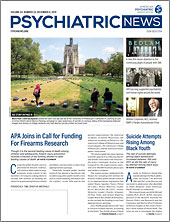Twenty years after the mass shooting at Columbine High School, some American schools have become high-security zones with elaborate procedures for entry into the property, active-shooter lockdown drills, and zero-tolerance policies that allow students to be suspended for minor infractions. But schools are safer than the public has been led to believe by media attention to high-profile mass shootings, and at least some of these policies and practices that schools are employing may be counterproductive, according to the report “Mass Violence in America: Causes, Impacts, and Solutions” by the National Council on Behavioral Health (NCBH).
“Your child is safer in school than she is driving with you in your car,” said Joseph Parks, M.D., medical director of the NCBH, at a session on mass violence at the IPS: The Mental Health Services Conference in October in New York. He was joined by John Rozel, M.D., an expert in threat assessment and president of the American Association for Emergency Psychiatry (see
story).
They summarized the findings and conclusions of the National Council report, emphasizing the need for a public health—rather than a punitive or fear-based—approach to prevention of mass violence. The report addresses mass violence in general, but Parks and Rozel highlighted some special recommendations for schools.
A priority of a public health approach to violence in schools is creating a positive climate for students to come forward because of mental health problems or concerns about other students who may be troubled.
“See Something, Say Something” programs that encourage students to approach authorities with information about a possible threat are essential in the creation of a culture and climate of safety, allowing timely, nonpunitive identification of students displaying mental distress.
A culture of safety also includes adequate teacher-student ratios and resources to provide in-school mental health and substance use evaluation and treatment or means for referral. And schools should make information about mental health widely available; the council recommendations specifically cite “Typical or Troubled?,” the APA Foundation program designed to help school personnel and others distinguish young people who are at risk or in need of treatment for mental or substance use disorders.
At the IPS presentation, Rozel and Parks underscored several practices and policies that schools should not employ. Among them:
•
Zero tolerance suspension policies. Many schools have adopted policies prohibiting not only guns or knives but all manner of objects or utensils that might be regarded as potentially dangerous, with suspensions or expulsions for violations. But suspensions and expulsions may increase a student’s isolation, alienation, and feelings of injustice and sense of hopelessness, which increase risk.
•
High-cost hard security measures. Schools should avoid measures that create a correctional facility–like atmosphere such as bulletproof glass, armed security guards, and metal detectors. These are costly and, as physical reminders of potential danger, can create a threatening atmosphere and an environment not conducive to education. Less heavy-handed measures such as limited entry points into the school and surveillance cameras can be just as effective and less intrusive.
•
Extremely realistic and dramatic active shooter drills. Some schools have employed surprise enactments with drawn guns and injury makeup. These can be traumatizing. “Shooter drills should be no more stressful or realistic than fire drills,” according to the council report. ■
